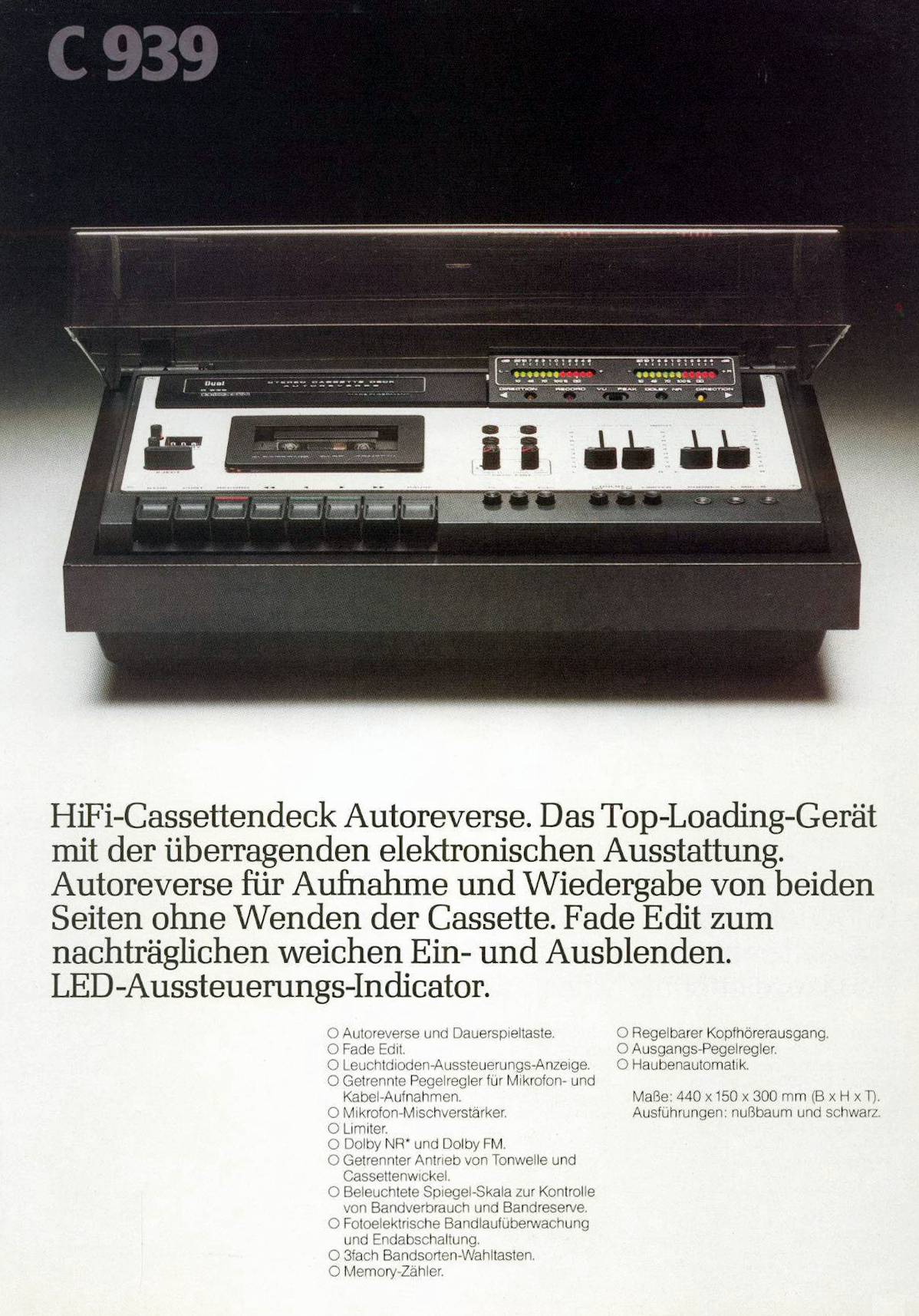Dual C 939
Data
General
- Manufacturer: Dual
- Model: C 939
- Type: Cassette deck
- Years of manufacture: 1977 - 1979
- Made in: Germany
- Colours: Silver, Brown, Black
- Remote control: no
- Power consumption: approx. 35 watts
- Dimensions: 440 x 105 x 300 mm (WxHxD)
- Weight: 7 kg
- Original price approx.: 1'050 DM
Connections
- Number of inputs: 3
- Microphone (2 jack sockets) 0,3mV/10kOhm
- Line in (DIN socket) 0.45mV/4.7kOhm
- Line in (RCA jacks) 70mV/82kOhm
- Number of outputs: 3
- Line out (DIN socket) 0-700mV/1.8kOhm
Line out (Cinch sockets) 0-700mV/1,8kOhm
- Headphones (jack socket) 4-2000Ohm
Technical data
- Audio heads: 3
- motors: 1
- Synchronous oscillations:
- Band types: CrO2, FeCr, Normal.
- Frequency response: Normal band 20-14000Hz, CrO2 band 20-16000Hz, FeCr band 20-17000Hz
- Distortion factor: 1,0-1,8 % (330Hz, 0db)
- Auto-Reverse: yes
- Title search: no
- Dolby: B, FM
- MPX filter: no
- Fader: no
- Pitch control: no
- CD synchro recording: no
Special Features
- Headphone output, adjustable
- Microphone input, mono/stereo
- Continous Play
- Fade edit (subsequent deletion of passages during playback)
- Tape counter with memory function
- Limiter for recording level
Remarks
- Other models in the same series:
- Integrated amplifier:
- Dual CV 31
- Dual CV 62
- Dual CV 121-1
- Dual CV 240
- [[Tuner:
- Dual CT 19
- Dual CT 125
- Receiver:
- Dual CR 120
- Dual CR 220
- Dual CR 230
- Tape Deck
- Dual C 819
- Dual C 919
- Dual C 919-1 Model without autoreverse, without fade edit, with VU pointer instruments instead of LED chains.
- Dual C 939
- Turntables:
- Dual CS 502
- Dual CS 510
- Dual CS 604
- Dual CS 621
- Dual CS 704
- Dual CS 721
- Dual CS 1225-1
- Dual CS 1249
- [[Loudspeaker:
- Dual CL 230
- Dual CL 240
- Dual CL 250
- Dual CL 260
- Dual CL 270
- Dual CL 370
- Dual CL 380
- Dual CL 390
Pictures
- Image: Dual C 939
- Excerpt from brochure: Dual C 939
Reports
- Test in "Hifi-Stereophonie" 9 / 1977
- The Dual C 939 Cassette deck is a further development of the Dual C 919, it replaced the VU meters by LED chains.
- This unit had Dolby-B and Dolby-FM circuits. The latter was used with FM/FM radio broadcasts to suppress noise and to tolerate the treble back out when for recording then the Dolby-B noise reduction was used.
By an Optokopler control whereby stroboscope-like flashes in the normal case the correct tape run signaled, came with a disturbance or tape end this to the stop or slowed down the STOP procedure was caused, by attracting a magnet which then the mechanical keys released. A so-called Fade-Edit circuit was also built in, with which one could then make targeted fade-outs at the end of the tape to round off the abrupt termination of the music - even with rear tape control! For this purpose, the erase head was used to variably erase the tape via a rotary controller that regulated the signal strength of the premagnetization frequency. The success could then be heard immediately via the audio head!
- Another feature of the Dual C 939 was the autoreverse facility.
With a little trick, you could even turn the machine into a continuous recording machine, for which the switch-off mechanism at the end of the tape again only switched the tape running direction and just again the tape was over-recorded - and just then the last minutes - depending on the maximum tape length were stored.
- On the right half of the device was a built-in mixer for two microphones (2x stereo, or 1x mono, with automatic switching) and an audio input.
This tape deck was undoubtedly one of the better ones from the late seventies and early eighties, especially since it was - after it was taken out of the manufacturer's program - sold off as a remaining stock at practically half the price. Better tape decks from the Far East were SIGNIFICANTLY more expensive at that time, but top-loaders were just out of fashion... Today, the C939 has only nostalgic value, because there are many decks on the second-hand market with much better sound and technology.
Links
- More pictures and information about this unit: http://bandmaschinen.jimdo.com
